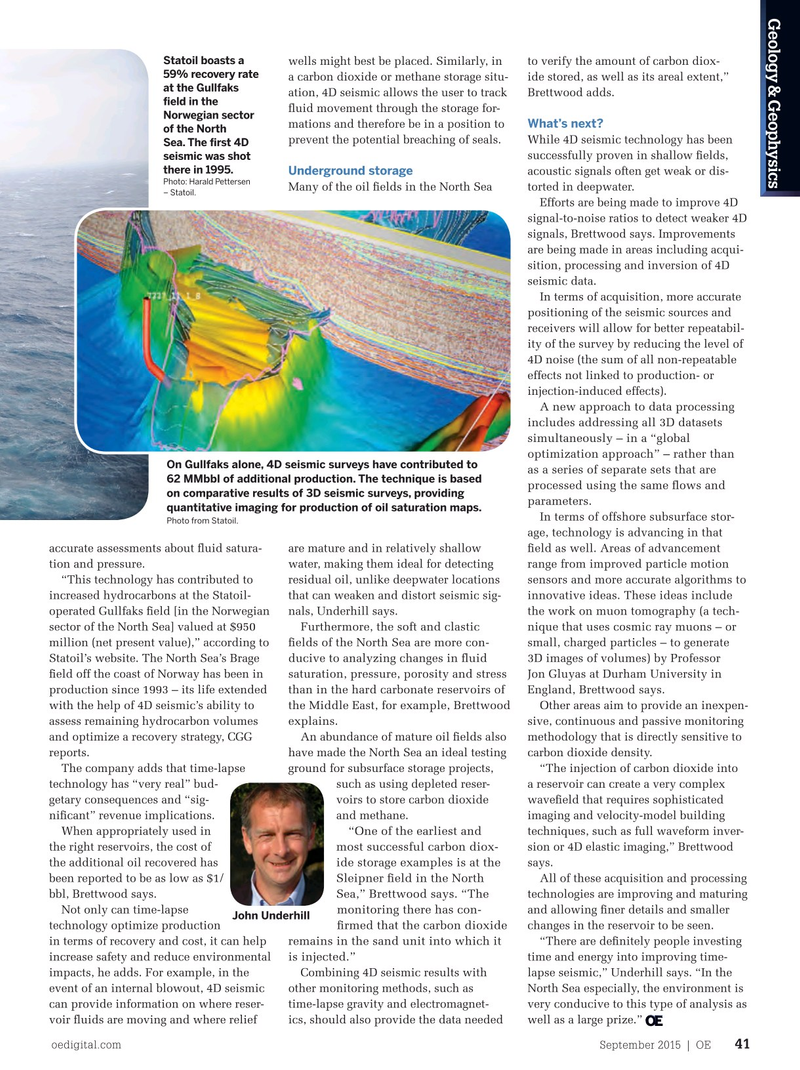
Page 39: of Offshore Engineer Magazine (Sep/Oct 2015)
Read this page in Pdf, Flash or Html5 edition of Sep/Oct 2015 Offshore Engineer Magazine
Geology & Geophysics
Statoil boasts a wells might best be placed. Similarly, in to verify the amount of carbon diox- 59% recovery rate a carbon dioxide or methane storage situ- ide stored, as well as its areal extent,” at the Gullfaks ation, 4D seismic allows the user to track Brettwood adds. feld in the fuid movement through the storage for-
Norwegian sector
What’s next?
mations and therefore be in a position to of the North prevent the potential breaching of seals. While 4D seismic technology has been
Sea. The frst 4D successfully proven in shallow felds, seismic was shot there in 1995.
Underground storage acoustic signals often get weak or dis-
Photo: Harald Pettersen
Many of the oil felds in the North Sea torted in deepwater. – Statoil.
Efforts are being made to improve 4D signal-to-noise ratios to detect weaker 4D signals, Brettwood says. Improvements are being made in areas including acqui- sition, processing and inversion of 4D seismic data.
In terms of acquisition, more accurate positioning of the seismic sources and receivers will allow for better repeatabil- ity of the survey by reducing the level of 4D noise (the sum of all non-repeatable effects not linked to production- or injection-induced effects).
A new approach to data processing includes addressing all 3D datasets simultaneously – in a “global optimization approach” – rather than
On Gullfaks alone, 4D seismic surveys have contributed to as a series of separate sets that are 62 MMbbl of additional production. The technique is based processed using the same fows and on comparative results of 3D seismic surveys, providing parameters. quantitative imaging for production of oil saturation maps.
In terms of offshore subsurface stor-
Photo from Statoil.
age, technology is advancing in that explaining that “moments” are often accurate assessments about fuid satura- are mature and in relatively shallow feld as well. Areas of advancement years apart. tion and pressure. water, making them ideal for detecting range from improved particle motion
Five years seems to be the ideal length “This technology has contributed to residual oil, unlike deepwater locations sensors and more accurate algorithms to of time in terms of cost-beneft analysis, increased hydrocarbons at the Statoil- that can weaken and distort seismic sig- innovative ideas. These ideas include
Underhill says. Over a 20-year period, operated Gullfaks feld [in the Norwegian nals, Underhill says. the work on muon tomography (a tech-
Furthermore, the soft and clastic four 3D surveys should be suffcient – sector of the North Sea] valued at $950 nique that uses cosmic ray muons – or felds of the North Sea are more con- depending on the reservoir, of course. million (net present value),” according to small, charged particles – to generate ducive to analyzing changes in fuid
The amount of change one might see in Statoil’s website. The North Sea’s Brage 3D images of volumes) by Professor saturation, pressure, porosity and stress one year does not justify shooting fre- feld off the coast of Norway has been in Jon Gluyas at Durham University in than in the hard carbonate reservoirs of quently, as 3D surveys are multi-million production since 1993 – its life extended England, Brettwood says. the Middle East, for example, Brettwood dollar operations, he explains. with the help of 4D seismic’s ability to Other areas aim to provide an inexpen- explains. “However, the expense of this technol- assess remaining hydrocarbon volumes sive, continuous and passive monitoring ogy more than justifes itself because you and optimize a recovery strategy, CGG An abundance of mature oil felds also methodology that is directly sensitive to are managing felds far better,” he says. reports. have made the North Sea an ideal testing carbon dioxide density. “You get more oil out of the ground in The company adds that time-lapse ground for subsurface storage projects, “The injection of carbon dioxide into the long run.” technology has “very real” bud- such as using depleted reser- a reservoir can create a very complex getary consequences and “sig- voirs to store carbon dioxide wavefeld that requires sophisticated
Qualitative to quantitative nifcant” revenue implications. and methane. imaging and velocity-model building
In 4D seismic technology’s When appropriately used in techniques, such as full waveform inver- “One of the earliest and most successful carbon diox-early stages, its accuracy was the right reservoirs, the cost of sion or 4D elastic imaging,” Brettwood ide storage examples is at the limited, keeping it a qualitative the additional oil recovered has says.
Sleipner feld in the North tool, primarily used to interpret been reported to be as low as $1/ All of these acquisition and processing
Sea,” Brettwood says. “The internal reservoir structures bbl, Brettwood says. technologies are improving and maturing monitoring there has con- and to identify depleted or Not only can time-lapse and allowing fner details and smaller
John Underhill frmed that the carbon dioxide “unswept” zones, according to technology optimize production changes in the reservoir to be seen.
remains in the sand unit into which it
CGG, a French seismic and data process- in terms of recovery and cost, it can help “There are defnitely people investing is injected.” ing frm. increase safety and reduce environmental time and energy into improving time-
However, advances in 4D processing, impacts, he adds. For example, in the Combining 4D seismic results with lapse seismic,” Underhill says. “In the in particular, have turned the technology event of an internal blowout, 4D seismic other monitoring methods, such as North Sea especially, the environment is into a quantitative reservoir manage- can provide information on where reser- time-lapse gravity and electromagnet- very conducive to this type of analysis as ment tool, with the ability to make more voir fuids are moving and where relief ics, should also provide the data needed well as a large prize.” oedigital.com September 2015 | OE 41 040_OE0915_G&G1_Heather.indd 41 8/20/15 10:55 AM

 38
38

 40
40